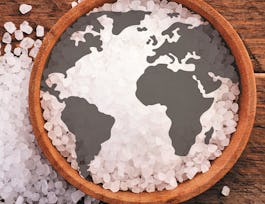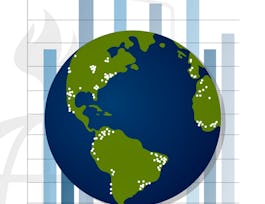Why would hundreds of scientists from around the world intentionally freeze a ship in Arctic sea ice for an entire year, braving subzero temperatures and months of polar darkness? This may sound like a fictional adventure movie plot, but from September 2019 through October 2020, the MOSAiC (Multidisciplinary drifting Observatory for the Study of Arctic Climate) Arctic research expedition did just this.


Frozen in the Ice: Exploring the Arctic
Taught in English
Some content may not be translated
3,793 already enrolled
(17 reviews)
What you'll learn
As virtual participants of the MOSAiC expedition, learners will explore all components of the Arctic climate system and how they are interconnected.
Explore what climate science is, what data scientists collect in the Arctic, and how their findings inform our understanding of weather and climate
Discuss the critical challenges the Arctic faces under a changing climate and how these changes impact our lives in the mid-latitudes
Details to know

Add to your LinkedIn profile
5 quizzes
See how employees at top companies are mastering in-demand skills


Earn a career certificate
Add this credential to your LinkedIn profile, resume, or CV
Share it on social media and in your performance review

There are 7 modules in this course
In this module, we will take you on a tour of the Arctic and discuss topics like Arctic geography and geopolitics before introducing the MOSAiC (Multidisciplinary drifting Observatory for the Study of Arctic Climate) expedition. The module wraps up with a brief look back at the historic Fram expedition to the Arctic 150 years ago that inspired MOSAiC.
What's included
6 videos4 readings2 discussion prompts2 plugins
In this module, you will learn about the basic physics of the atmosphere with a specific focus on the Arctic. We will explore Earth’s energy budget and look at the structure of the atmosphere. Arctic clouds are an important player in the Arctic atmosphere and their role will be part of one video lecture. Finally, we will introduce you to the concept of feedbacks, systems responses that modulate the climate system and are the basis for connections to the lower latitudes. The module concludes with an overview of the goals of the MOSAiC Atmosphere research group and the data they are collecting.
What's included
7 videos3 readings1 quiz1 discussion prompt
In this module, we will take you on a tour of the Arctic Ocean. We will explore topics like ocean circulation and ocean stratification with a specific focus on processes that are happening in the Arctic. You will begin to draw connections to the coupling of the atmosphere, ocean, and sea ice and explore the chemistry of the ocean, nutrient distribution, and ocean productivity. The module concludes with an overview of the goals of the MOSAiC Ocean research group and the data they are collecting.
What's included
7 videos2 readings1 quiz1 discussion prompt
In this module, you will learn about sea ice and the important role it plays in the Arctic climate system. We will discuss how sea ice forms, how sea ice interacts with sunlight, and how sea ice moves and behaves. We will also explore the change in sea ice thickness and distribution in the Arctic over time and in response to a changing climate. The module concludes with an overview of the goals of the MOSAiC Sea Ice research group and the data they are collecting.
What's included
9 videos2 readings1 quiz1 discussion prompt
In this module, you will learn about the ecosystems of the Arctic Ocean. We will briefly explore the megafauna, such as polar bears, but then focus the exploration on the importance of the microfauna, such as algae and plankton, and their connections to oceanic nutrient cycles and atmospheric phenomena. The module concludes with an overview of the goals of the MOSAiC Biogeochemistry and Ecosystems research group and the data they are collecting.
What's included
8 videos2 readings1 quiz1 discussion prompt
In this module, you will dive into the world of climate modeling. You will learn from MOSAiC researchers what the different modeling approaches are, what we can learn from models, and how we can use field data from expeditions like MOSAiC to improve model forecasts. The module concludes with an overview of the goals of the MOSAiC Modeling research group and the data they are collecting.
What's included
6 videos2 readings1 quiz1 discussion prompt
In this module, we will tie together what we learned in the previous modules and explore challenges that the new Arctic faces. We will discuss the impacts of a changing climate on the Arctic as a whole, discuss the research frontiers around connections between the Arctic and lower latitudes, and explore the potential impacts of climate change on shipping lanes, energy exploration and fishing as well as related environmental challenges such as plastics and oil spills. Finally, you will learn how climate change is already impacting and will continue to impact indigenous communities in the Arctic in different ways.
What's included
9 videos1 reading1 peer review1 discussion prompt1 plugin
Instructors


Offered by
Recommended if you're interested in Research Methods

Johns Hopkins University

Johns Hopkins University

Coursera Instructor Network
Why people choose Coursera for their career





Open new doors with Coursera Plus
Unlimited access to 7,000+ world-class courses, hands-on projects, and job-ready certificate programs - all included in your subscription
Advance your career with an online degree
Earn a degree from world-class universities - 100% online
Join over 3,400 global companies that choose Coursera for Business
Upskill your employees to excel in the digital economy
Frequently asked questions
Access to lectures and assignments depends on your type of enrollment. If you take a course in audit mode, you will be able to see most course materials for free. To access graded assignments and to earn a Certificate, you will need to purchase the Certificate experience, during or after your audit. If you don't see the audit option:
The course may not offer an audit option. You can try a Free Trial instead, or apply for Financial Aid.
The course may offer 'Full Course, No Certificate' instead. This option lets you see all course materials, submit required assessments, and get a final grade. This also means that you will not be able to purchase a Certificate experience.
When you purchase a Certificate you get access to all course materials, including graded assignments. Upon completing the course, your electronic Certificate will be added to your Accomplishments page - from there, you can print your Certificate or add it to your LinkedIn profile. If you only want to read and view the course content, you can audit the course for free.
You will be eligible for a full refund until two weeks after your payment date, or (for courses that have just launched) until two weeks after the first session of the course begins, whichever is later. You cannot receive a refund once you’ve earned a Course Certificate, even if you complete the course within the two-week refund period. See our full refund policy.



